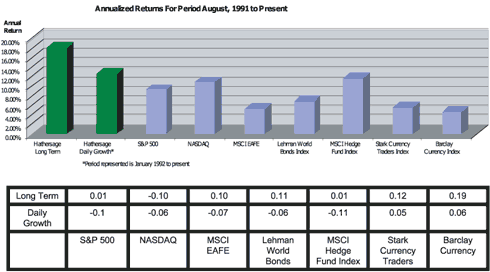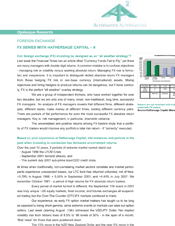FX Series with Hathersage Capital – II
- 7/13/12 – New Report Suggests a Better Way to Evaluate Currency Traders
- 3/30/12 – Flexibility is Key for Currency Fund Managers
- 2/22/10 – Can the Euro Zone Cope with a National Bankruptcy?
- 3/24/09 – FX to the Fore: Risk & Return in a Post Crisis Era
- 2/18/08 – FX, A New Asset on the Menu for Investors
- 11/20/07 – Currency of Change
- 8/21/07 – Opalesque Research FX Series - II
- 8/14/07 – Opalesque Research FX Series - I
- 8/1/07 – The Perfect Portfolio Partnership
- 7/1/07 – The Risk 20 Awards: Currency Derivatives
- 5/28/07 – Russell, Hathersage Vets Seek to ID Role of FX
- 10/1/06 – Married to the Market
- 8/1/06 – How Lipschutz Downsized to Bigger Things [!]
- 6/30/06 – Foreign Exchange Comes of Age
- 6/26/06 – Hathersage Forex Trades Are All About Options
- 4/5/06 – Changes in FX Market May Cause Shakeout
- 3/30/06 – Slumping FX Funds Bet on Soft Dollar, Emerging Mkts [/!]
Opalesque Research
Issue 29
August 21, 2007
Bill Strack, Hathersage Director, Portfolio Management looks at FX strategies and returns.
Can foreign exchange (FX) investing be designed as an “all weather strategy”?
Last week the Financial Times ran an article titled “Currency Funds Fail to Fly,” yet there are many managers with double digit returns. A common mistake is to confuse objectives - managing risk or volatility versus seeking absolute return. Managing FX risk is formulaic and inexpensive. It is important to distinguish skilled absolute return FX managers from those hedging FX risk in non-base currency (international) assets. Mixing objectives and hiring hedgers to produce returns can be dangerous, but if done correctly, FX is the perfect “all weather” overlay strategy.
We are a group of independent thinkers who have worked together for over two decades, but we are only one of many small, non-traditional, long time, successful FX managers. An analysis of FX managers reveals that different firms, different strategies and different styles, make money at different times, trading different currency pairs. There are periods of flat performance for even the most successful FX absolute return managers. Key is: risk management, in particular, downside variance.
The uncorrelated and positive returns among FX traders imply that a portfolio of FX traders would improve any portfolio’s total risk return - if “correctly” executed.

Based on your experience at Hathersage Capital, cite instances and periods in the past when investing in currencies has delivered uncorrelated returns.
Over the past 10 years, 3 periods of extreme market turmoil stand out:
• August 1998 the LTCM crisis
• September 2001 terrorist attacks
• July 2007 sub-prime loan/CDO credit crisis
At times when traditionally non-correlated market sectors correlate and market participants experience unexpected losses, our LTC Program has returned unfunded, net of fees +3.79% in August 1998, +5.05% in September 2001 and +4.40% in July 2007. We remember October 1987 - a period of high returns for FX absolute return traders.
Every period of market turmoil is different. The September 11th event in 2001 was unique. US equity markets, fixed income and futures exchanges all suspended trading but the Over-The-Counter (OTC) FX markets continued to trade.
Our experience as early FX option market makers has taught us to be long as opposed to being short gamma, since extreme events or markets can wipe out option sellers. Last week (starting August 13th) witnessed the USD/JPY implied volatility rise from historic lows of 8.5% to ‘98 levels of 30% in the span of a month. “Bad news” for those that were positioned short.
The 13% move in the NZD/USD and the near 5% move in the USD/JPY over the past few days have severely hurt highly leveraged players. We believe it is important, particularly during periods of market stress, not to be in the same trade as the rest of the market, too big for the market or dependent on leverage which can quickly drown you.
We enter a trade with a variety of exit strategies (spot, forward and option) in mind and closely manage our exposure, which is simply the amount we are willing to risk. Our overall position is generally slightly deleveraged to the size of the account, which gives us even more opportunities during periods of market turmoil and price dislocations. Strict adherence to risk management, good operations and a keen understanding of when and how to take on risk exposure has not only ensured our survival through a variety of market cycles, but we have been able to repeatedly deliver uncorrelated returns.
No one can predict market events. Moves can be quick and strong, driving all asset prices down at once. While it may take months to fully understand true asset values in illiquid markets or how highly leveraged non-transparent managers are, there is no uncertainty regarding valuation in FX and there are no mysteries that shroud leverage owing to the full transparency afforded by managed accounts.

